Living in the desert
Animals adapt in unusual ways to survive in some of the hottest, driest places on Earth.
When you’re hot and thirsty, you’re likely to drink a glass of cold water or head for a shady spot to cool down. What you surely don’t do is shrink your liver to a fraction of its original size.
But that’s just what a type of gazelle does to beat the desert heat.
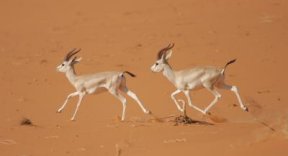 |
|
Sand gazelles live in the deserts of the Saudi Arabian peninsula.
|
| Courtesy of Stéphane Ostrowski |
Sand gazelles live in the deserts of Saudi Arabia. These animals allow their livers to shrink by up to 30 percent—all in an effort to conserve water.
It’s one of many unusual adaptations that animals make to survive in some of the hottest, driest places on Earth.
Saving water
How can the size of an animal’s liver affect water conservation?
It has to do with the cell structure of the liver and its energy needs, says Joe Williams. He’s a biologist at Ohio State University and one of the authors of a recent study of sand gazelles.
The cells that make up the liver are packed with objects called mitochondria. The mitochondria change food into energy for growth and other functions in living things. This process requires oxygen, and the oxygen comes from air that animals breathe.
The catch? “Every time you exhale, you lose water,” Williams says.
The body keeps the inside of the lungs moist, he explains. But every exhalation picks up some of this water as vapor and carries it out of the body—something you can feel if you exhale into your hands a few times.
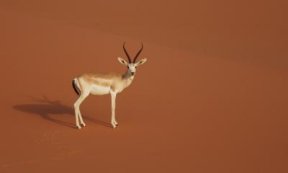 |
|
A sand gazelle can shrink its liver to conserve water.
|
| Courtesy of Stéphane Ostrowski |
Williams and his coworkers suggest that by shrinking their livers during times of extreme water shortages, sand gazelles decrease the number of active mitochondria.
As a result, these animals “breathe less often and, over time, lose less water,” he says.
Every drop
Other mammals conserve water by using it as efficiently as possible. To do this, they squeeze out every drop available to them and recycle it in their bodies.
The kangaroo rat, which lives in the desert of southeastern Arizona, is so good at conserving water that it doesn’t have to drink at all. It gets all the water it needs from eating seeds.
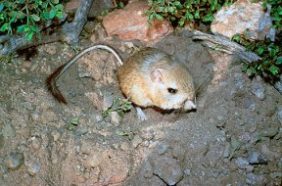 |
|
Kangaroo rats get all the water they need from seeds.
|
| Photo by George Harrison, U.S. Fish & Wildlife Service |
All seeds have a certain amount of free water, and kangaroo rats have adapted to preserve as much of this water as possible, says Yar Petryszyn. He’s curator of mammals at the University of Arizona department of ecology and evolutionary biology.
“You’d have the same source of water if you ate only seeds, but you wouldn’t even begin to be able to survive” with so little water, Petryszyn says. People “lose too much water in other ways—breathing, sweating to keep cool, processing waste.”
A mammal’s kidneys contain long tubes through which liquid waste passes on its way out of the body as urine. The tubes allow an animal to extract water for reuse.
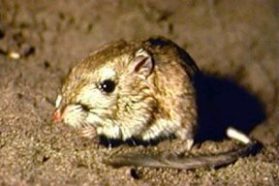 |
|
A kangaroo rat’s kidneys help it conserve water.
|
| National Park Service |
It turns out that a kangaroo rat’s kidney tube is about five times as long as the same structure in other rodents, Petryszyn says.
The tube’s greater length gives it much more surface area. As a result, the animal can reabsorb greater amounts of water and put that water back into its bloodstream, Petryszyn explains.
Kangaroo rats save a lot of water this way. Because the rats reabsorb so much water, the urine they expel is highly concentrated.
Seed storage
Kangaroo rats and their desert cousins, pocket mice, share another feature that helps them survive in the desert: external cheek pouches that they use to temporarily store their food.
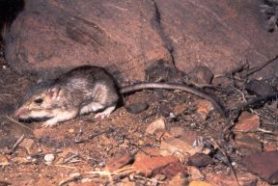 |
|
Like kangaroo rats, pocket mice don’t need to drink water.
|
| National Park Service |
Other rodents, such as hamsters and mice, have internal cheek pouches for storing food. When they’re out foraging and find a seed, they simply open their mouths and tuck it in.
“Kangaroo rats can’t afford to do that because they would lose a lot of water if they had to open their mouths in the dry desert air every time they found a seed,” Petryszyn says.
To get an idea of what he means just try talking for an hour, without drinking anything, to see how quickly your mouth dries out.
Kangaroo rats and pocket mice stuff seeds in their external cheek pouches. They can do this with their mouths closed. Once the rats return to their nests, they can empty the pouches, again without opening their mouths.
As a second water-saving feature, these animals have structures in their nostrils that reabsorb water vapor from the warm air they exhale, Petryszyn says.
Bird care
The sand grouse might take the prize for the most dedicated parenting among desert animals, Williams says.
This small bird flies from 50 to 60 kilometers (30 to 37 miles) to the nearest river, where it soaks its chest feathers in the water.
When the sand grouse returns to its nest, it allows its nestlings to “suckle” the water from the feathers. “The feathers are designed like a sponge,” Williams says. “Even though water evaporates on outside feathers, there’s water left on the inside.”
Why is water so important to survival for animals? Wouldn’t desert animals have an easier time if their bodies didn’t depend on water?
“Every cell is about 80 percent water, and every chemical reaction important to life requires water,” Williams says. “Life just doesn’t exist without it.”







